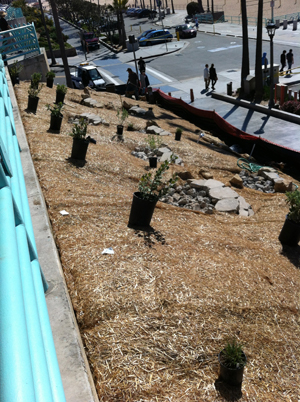Many “native” plant advocates propose that soil amendment, even biological community amendment, is not necessary when planting “native” plants in “native” soils. For many reasons, G3 has always advocated testing the soil for biological activity and then determining a remediation strategy based on the type of plants intended for the site and the actual biological conditions in the soil at the time of planting.
“Native” soils are a misnomer, as the degrading effects of air, soil, and water pollution as well as compaction and dehydration are present throughout the world regardless of land use (commercial, public, agricultural, residential, or “open space”). Most people gardening or landscaping in urban and suburban settings are dealing with subsoil or minimal and compacted topsoil conditions, so while the soil may be “native” to the place, it is also most certainly, degraded and unsuitable for sustaining healthy plant life, especially those that are climate-adapted, such as local “native” plants.
Living biological amendment is not the same as “soil enrichment.” On the contrary, G3 is advocating building the appropriate living soil community that can supply the appropriate plant life with the most efficient nutrient cycling on demand. This is a far cry from enrichment or fertilization which could lead to the intrusion of invasive species.
Today we ran across an article on Foredune Reestablishment at Bolsa Chica State Beach (ForeduneReestablishment3), published in Fall 2012 by D. Pryor. We found the reference to mycorrhizal fungi presence and role in establishing dune plants extremely interesting:
Mycorrhizal fungi are commonly found in sand dunes with and without abundant plants, and it is suggested to add the material while seeding foredune species. These fungi have resulted in more rapid establishment of transplants and stabilization of dunes.
Now that the Manhattan Beach Strand Ocean Friendly Demonstration Garden is moving into its final days of construction, we are concerned with building the biological community right around the roots of the plants. The majority of the plant material (all of which is CA native, and most of which is specific to the Manhattan Beach area) was laid out by Alison Terry, G3’s Lead Designer and Licensed Landscape Architect, and will be planted by Stout Design:Build’s crew. Once the plants are in place and the fresh woodchip mulch (donated by the City of Manhattan Beach) has been spread over the coir erosion control blanket, Sheri Powell-Wolff, CompostTeana (G3 Certified Professional 2009) will be called upon to spray the plants and surrounding mulch with fungally-abundant compost tea.


